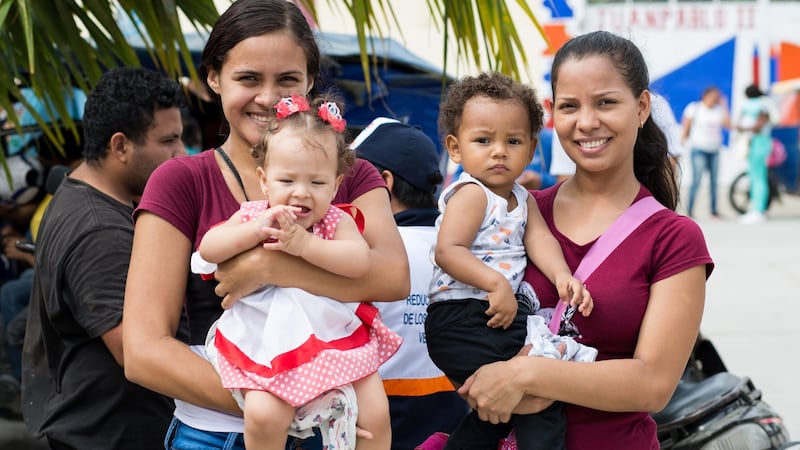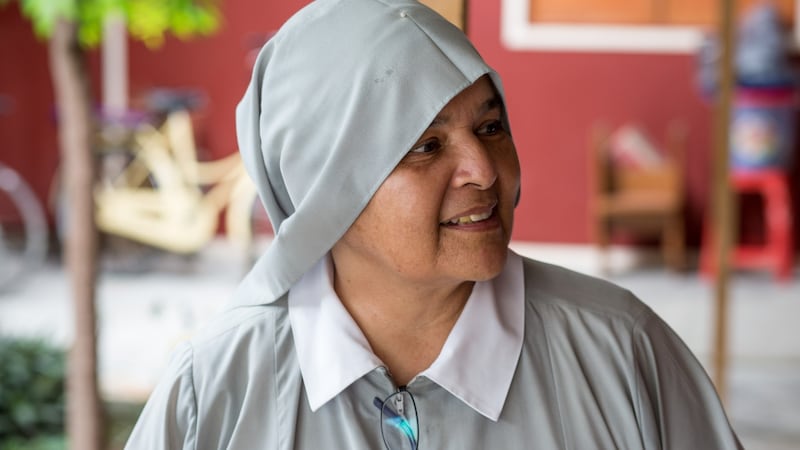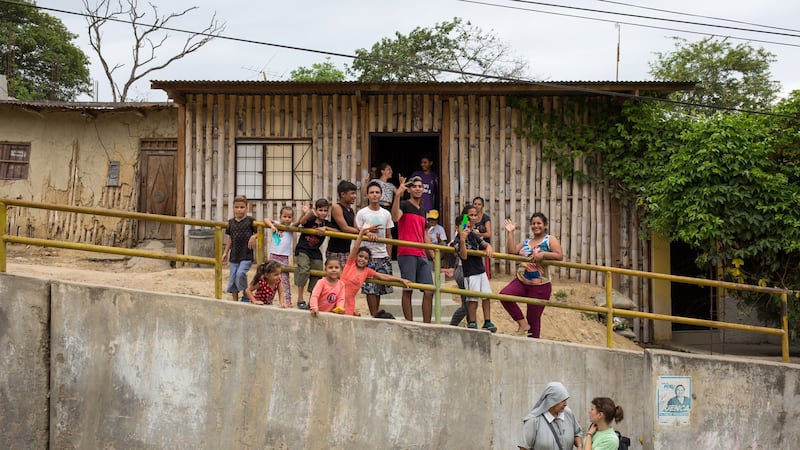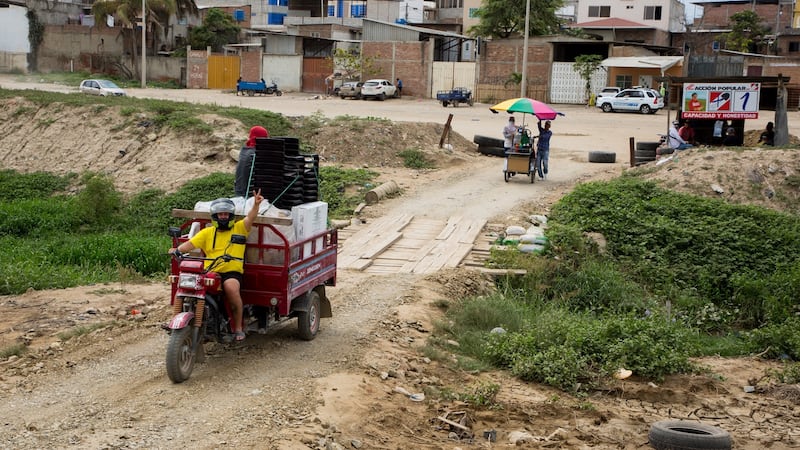It's a humid, overcast morning and dozens of families have gathered on a suburban street in the town of Zarumilla in northern Peru. Children scramble over a stationary rickshaw while their parents peer anxiously through the gates of a small, unassuming building.
Maibel sits on the pavement holding her son Abdiel whose skin is covered in mosquito bites. The one-year-old neither smiles nor laughs when children pass by. His older brother Adonay is similarly uncommunicative and remains glued to his father’s side.
The family have been sleeping in the local park since crossing the border into Peru from Ecuador, just 3km away. Maibel uses bottled water to wash her children and has no money for food.
Like the 50 other Venezuelans waiting nearby, they have come to this office run by Care Peru seeking financial support. Maibel (32) fears her children won’t survive much longer on the streets. “We’re human beings, I want my son to be able to go to school,” she says as tears stream down her face. “We’re scared of sleeping in the park. My one year old isn’t vaccinated and he’s covered in mosquito bites. We just hope people here can help.”
Dayana Castro stands nearby with her sons Gabriel and Aquiles. She arrived in the country nine months ago and now sells empanadas on the streets of Zarumilla. "When we arrived we were all underweight," she says. "We had no food in Venezuela, there was nothing left."
Her mother Sunilde followed her family to Peru a month ago. “I came here alone, it was horrible. At least here we have a chance here and it’s safer. We have food and the children can go to school.”

Yesenia Escobar Cordova, a volunteer with Care, also migrated alone with her three children. The family was robbed in Colombia, something many Venezuelans experience while travelling.
“I came here because of the Venezuelan economy and lack of healthcare. Peru seemed like a calmer and safer country.”
More than five million Venezuelans have left since 2015, fleeing poverty, hunger, fuel shortages and political turmoil, making it the second largest displacement emergency in the world after the Syrian crisis. This number is expected to rise to eight million by the end of 2020.
Anti-government protests, which started in 2014, have been met with violence by Venezuelan security forces while tensions between the country’s president Nicolás Maduro and opposition leader Juan Guaido (who is recognised by about 60 countries as Venezuela’s interim president) remain heightened.
In 2018, Human Rights Watch warned the country’s health system had “collapsed” and last year reported that more than half of Venezuela’s doctors had fled. Even before Covid-19, the country was experiencing thousands of cases of tuberculosis, measles and diphtheria with reports of a “malaria epidemic” across nine Venezuelan states.
While Colombia has become the primary destination for Venezuelans (1.8 million people) Peru is now second largest host country for Venezuelan migrants with 870,000 new arrivals since 2017, according to official statistics.
In reality, the actual number in Peru may be well above one million given the significant number of Venezuelans entering the country illegally.
Like Ireland, Peru has a history of emigration – an estimated 3.5 million Peruvians (equivalent to 10 per cent of the population) have moved abroad in recent decades because of economic instability and the Shining Path terrorist movement in the 1980s and 1990s. While these numbers have dropped, the International Organisation for Migration reported in 2012 that 100,000 Peruvians continued to leave per year.
Peru initially welcomed Venezuelan migrants. However, measures implemented by the government to regulate numbers over the past year, including the introduction of a specialised police force to tackle migrant criminality, have been harshly criticised. The labelling of Venezuelans as criminals and murders by Peruvian media networks and political figures has also contributed to a growing sense of fear.
Before 2019 Venezuelans could enter Peru without a visa and apply for the PTP card (Permiso Temporal de Permanencia) – a year-long permit which allowed them to work or study. However, as the number of arrivals rapidly increased, the government brought an end to the permit in 2018. Also that year, Peruvian authorities announced that Venezuelans needed to show a passport to enter the country – a document which only half of Venezuelans reportedly hold.

In June 2019, when the number of arrivals peaked at around 5,000 Venezuelan arrivals per day, Peru introduced the “humanitarian visa” which could be obtained at Peruvian consulates in Venezuela, Colombia or Ecuador. However, to qualify for the visa Venezuelans needed to present a passport and proof of any criminal record. The introduction of Ecuador’s humanitarian visa two months later meant any Venezuelan seeking to enter Peru also needed the Ecuadorian document to pass through the country.
Exceptions were made for people over the age of 60, pregnant women, those in need of medical care and minors seeking to reunite with family members, but entry into Peru was still often left up to the border control officials.
In a report published in February 2020, Amnesty International described the humanitarian visas as an "unviable form of protection" and warned of the "serious and rapid deterioration" in Peru's treatment of refugees.
While the charity praised Peru for initially displaying “admirable generosity”, it accused the government of “engaging in a deliberate policy of turning away asylum-seeking woman, men, and children from Venezuela”.
Venezuelans are being “left in legal limbo” on the country’s borders, unable to return to Ecuador or enter Peru, said Joel Jabiles, advocacy and campaigns coordinator with Amnesty Peru.
“Without the humanitarian visa people have no other option but to enter the country illegally. They’re forced to take risks that leave them open to trafficking and violence.”
Up until recently, large numbers of Venezuelans chose to apply for asylum with 482,571 applications for protection made by the end of last year, far above the 129,988 applications made in Brazil. However, the fact that people must wait in a border refugee camp for an initial decision on their claim – sometimes for more than two months – has discouraged new arrivals from applying.
Official government statistics show that between June and December 2019 only 27 per cent of claims were accepted. NGOs say the actual number is 13 per cent.
Soup kitchen
In the town of Corrales, about 30km south of Peru’s border with Ecuador, Mother Sofia runs a soup kitchen and refuge for Venezuelans passing through the town. Most are undocumented and plan to travel on to Lima.
Two years ago nuns from the daughters of St Anne religious congregation converted the kitchen (which has been in operation for 30 years) into a canteen for Venezuelan families. Mother Sofia opened the refuge – a small shack on the outskirts of the town – when a local businessman offered the property free of charge.

“There was no light, running water or floors in the building. We went around knocking on doors and found someone to put down cement and got donations of mattresses.
“We could see Venezuelan families sleeping on the streets with nothing. Adults and children were arriving here underweight. It’s a harsh and painful reality. They have no food and no work, they’ve come here for a better future.”
Mother Sofia says there has been a significant increase in police raids rounding up undocumented Venezuelans. “I went directly to the police and said the soup kitchen and refuge are protected by our religious family, you cannot arrest people in our space.”
The refuge, which currently houses 32 mostly women and children, consists of two dark rooms with bed sheets hung from the ceiling for privacy between sleeping quarters. The mattresses in the second room, which was damaged by flooding the week before my visit, have been pushed aside to allow the children to play during the afternoon.

Carmen (26) has spent one month in the refuge with her husband and three daughters. “All the teachers left Venezuela, the education system was falling apart so we had to leave,” says Carmen.
The couple plan to request asylum in Peru but are trying to find their feet first. “We feel safer here, we’d like to stay,” says Carmen.
Juanita, a Peruvian volunteer at the refuge, says she was shocked by the condition of Venezuelans arriving over the border. “I’ve never seen anything like this in my life. Thank god Madre Sofia is here to help them. It doesn’t matter what time they arrive knocking on the door, she’s always there.”
Mother Sofia sits nearby rocking one-month-old baby Axel in her arms while half a dozen children gather around her chair. She lowers her voice to a whisper as she explains that three children from the refugee have died in the past year, mostly from illnesses connected to malnutrition.
The local businessman needs the property back to house seasonal farm labourers, and she is worried about where the families will end up. “There’s no light here, there’s ants and mosquitos, but at least they have a roof over their heads.”
About 30km away, the small number of families who have applied for asylum are living in prefabricated shelters while they await a decision on their application from Lima. When I visit the immigration control point at the Centro Binancional de atención fronteriza there are about 100 people staying at the makeshift refugee camp, down from the estimated 5,000 who were there in June 2019.
Mothers and children sleep together in the camp while men and teenage boys are housed in separate cabins, explains Ariana from Plan International. Children do not attend school but can take part in activities organised by NGOs on site. Parents are provided with supplies for babies and adults receive hygiene packs and daily access to showers.
While the camp is generally considered safe for families, fights do break out among some men, says Ariana. “People spend a lot of time here and that can lead to stress which can result in violence and aggression. But we have support in dealing with it.”
Venezuelans who do not intend to apply for asylum do sometimes enter the camp but are picked up by police, she says, adding that they are still given a chance to apply for protection. “Those who want to enter this country legally say they don’t care how long they have to wait for an answer.”
Gay teenager
Simon has already spent three months waiting for an answer on his application when we meet. The 18-year-old student fled his home country because of the economic instability and the way he was treated as a gay teenager. He hopes to join his father in Lima but does not feel safe in the camp.
“I’m very vulnerable here. I’ve always experienced homophobia from Venezuelans but it’s extremely difficult when you witness your own people treating you badly in this situation.
“My main goal is to get back into education. At least I’m in the system but the wait is long and there’s so many rules to follow. There’s no priority for someone like me facing additional discrimination in this place.”
Luis Coraspe (21) and his girlfriend Gabriela Gutierrez (17) have been in the camp for over a month. They arrived in January with their nine-month-old daughter Luisangelis, Gabriela’s brother Isaac and her mother Francis.
Asked why they decided to register with the authorities rather than enter the country illegally, Coraspe says applying for asylum just made sense. “We want to be able to study and work and live our lives in peace. We can’t live our lives on the run.”
Like most Venezuelans, the family left the country after they ran out of money and food. They travelled on buses and by foot across Colombia and Ecuador – a journey that’s taken its toll on baby Luisangelis.
“She’s always sick and has diarrhoea and vomits,” says Francis. “She has her vaccinations but she often has a fever. Thank god we have nappies and food here.”
Coraspe left his mother behind in Venezuela to care for his grandmother who suffers from Alzheimer’s. He worked as a barber back home and is eager to find work in Peru as soon as possible. “You need a lot of patience here. We just want to get to Lima and start over.”
Immigration checks rarely take place at the bridge connecting the nearby town of Aguas Verdes with Huaquillas in Ecuador, meaning most Venezuelans cross without being stopped (the CEBAF immigration control centre is 8km south of the border).

There is a small police presence at this official border but raids on illegal migrants take place further down the highway. Taxi drivers who used to take advantage of the steady stream of Venezuelan arrivals no longer transport migrant passengers for fear of police fines.
Venezuelans who are arrested can be barred from entering the country for five years. If they’re caught without papers a second time, this rises to 15 years and a third time, they’re barred for life.
Migrants have found other routes to cross into Peru, including a narrow dirt track on the outskirts of Huaquillas that runs parallel to the main national highway.
Percy Gómez Barreto, my driver for the duration of my stay in northern Peru, says 90 per cent of migrants used to cross into Peru using the international bridge but that the estimated 200-300 who now arrive each day use a more clandestine route.
“To be honest, they aren’t actually controlling the land border. People arrive by foot every day along that abandoned dirt road into Peru.”
Maxfredid Pérez Rodríguez, chief of police for Tumbes region, is conscious of the many routes Venezuelans use to enter the region but says controlling a porous border which stretches for hundreds of kilometres is challenge.
Rodríguez says he had nothing against the first wave of Venezuelans to arrive in Peru – “professional, cultured people” – but feels differently about the more recent arrivals.
“Things changed when the robberies and assaults began. I don’t think it’s too much to ask these people to behave themselves when we’re welcoming them into our country. We’ve entered a third wave of Venezuelans and they have certain characteristics – they’re more aggressive. Crime has gone up in Tumbes, that much is clear.”
Difficult times
Lita Orrego, head of Migration for Tumbes, says the government is still focused on supporting Venezuelan migrants.
“These people are our brothers and must leave their entire lives behind to start afresh. We as Peruvians have been through difficult times ourselves and know what migration is like. We need to work to integrate Venezuelans into our communities and fight against any xenophobia towards these people.”
Supports were ramped up when the Peruvian government declared a state of emergency in March in response to the Covid-19 pandemic and asylum seekers were brought to hotels where they could self-isolate, says Orrego. With Peru’s borders closed indefinitely, no Venezuelans are currently trying to enter the country, she claims.
In reality, however, Venezuelans continue to arrive. Before the pandemic, most of these migrants lived off work in the informal economy, but now, with the shutdown, they have no money for food, says Maria Teresa Rodriguez from Care Peru.
“There are children begging on the streets and state support for the pandemic does not extend to Venezuelans without papers. People have lost their homes because they cannot pay rent. We’re receiving so many calls looking for help, but our project can barely survive right now. The coronavirus is difficult for Peruvians but it’s even worse for Venezuelans.”
This assignment was supported by the Simon Cumbers Fund



















